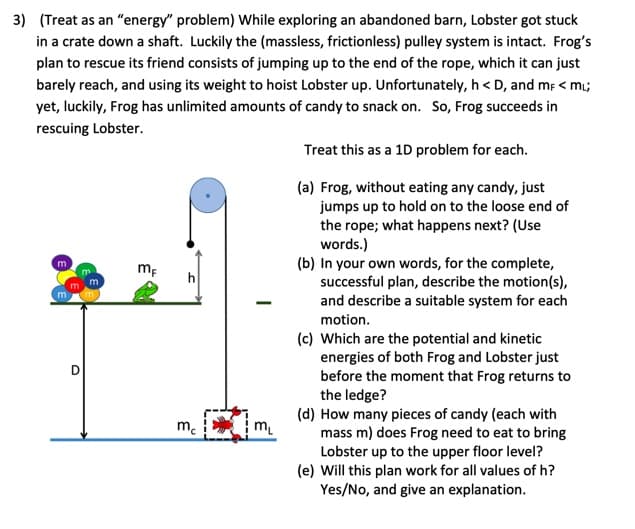3) (Treat as an "energy" problem) While exploring an abandoned barn, Lobster got stuck in a crate down a shaft. Luckily the (massless, frictionless) pulley system is intact. Frog's plan to rescue its friend consists of jumping up to the end of the rope, which it can just barely reach, and using its weight to hoist Lobster up. Unfortunately, h
3) (Treat as an "energy" problem) While exploring an abandoned barn, Lobster got stuck in a crate down a shaft. Luckily the (massless, frictionless) pulley system is intact. Frog's plan to rescue its friend consists of jumping up to the end of the rope, which it can just barely reach, and using its weight to hoist Lobster up. Unfortunately, h
Related questions
Question
Hello,
Can someone please show how to solve parts a b and c please?
Thank you

Transcribed Image Text:3) (Treat as an "energy" problem) While exploring an abandoned barn, Lobster got stuck
in a crate down a shaft. Luckily the (massless, frictionless) pulley system is intact. Frog's
plan to rescue its friend consists of jumping up to the end of the rope, which it can just
barely reach, and using its weight to hoist Lobster up. Unfortunately, h<D, and mF < mi;
yet, luckily, Frog has unlimited amounts of candy to snack on. So, Frog succeeds in
rescuing Lobster.
m
m
O
m
mF
h
3
mc
-
m₁
Treat this as a 1D problem for each.
(a) Frog, without eating any candy, just
jumps up to hold on to the loose end of
the rope; what happens next? (Use
words.)
(b) In your own words, for the complete,
successful plan, describe the motion(s),
and describe a suitable system for each
motion.
(c) Which are the potential and kinetic
energies of both Frog and Lobster just
before the moment that Frog returns to
the ledge?
(d) How many pieces of candy (each with
mass m) does Frog need to eat to bring
Lobster up to the upper floor level?
(e) Will this plan work for all values of h?
Yes/No, and give an explanation.
Expert Solution
This question has been solved!
Explore an expertly crafted, step-by-step solution for a thorough understanding of key concepts.
Step by step
Solved in 4 steps with 1 images
